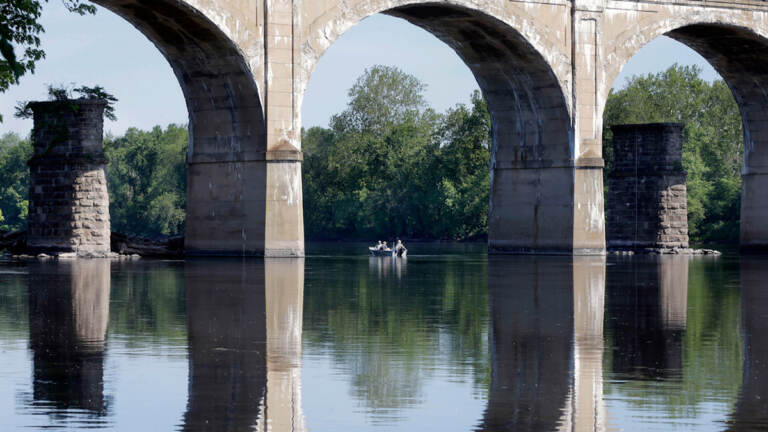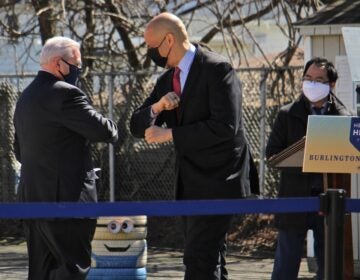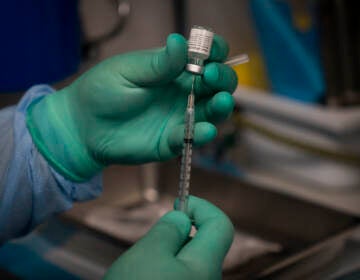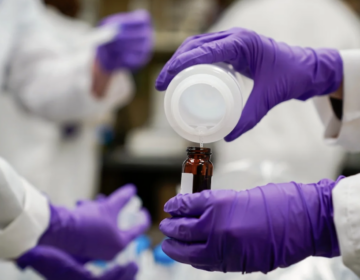Infrastructure funds go to New Jersey conservation projects
Programs in the Delaware River Basin include a turtle habitat in South Jersey and stream-bank restoration at Lake Hopatcong.

The Delaware River in the West Trenton section of Ewing Township. (AP Photo/Mel Evans)
This story originally appeared on NJ Spotlight.
From stream restorations at Lake Hopatcong to protecting bog turtles in South Jersey, conservation projects across the state will get a boost from the Infrastructure Investment and Jobs Act that President Joe Biden signed into law on Monday.
The new law provides an extra $26 million over five years for conservation projects supported by the federally funded Delaware River Basin Restoration Program, run by the U.S. Fish & Wildlife Service. The money, for projects starting in October 2022, is in addition to federal funds that have already been appropriated.
The program’s goals are to support natural habitat, improve water quality, build stormwater management, and enhance recreational access in the four states that are covered by the Delaware River watershed — New Jersey, New York, Pennsylvania and Delaware. It also prioritizes interconnections between parts of natural systems.
“In the 21st century, conservation work must consider connections at very large scales — such as a 14,000-square-mile Delaware River Basin — to be relevant, to be durable, and to be resilient to large scale stressors like climate change and land use development,” said Christina Ryder, Delaware River Watershed Program Manager for Science Applications at the Fish & Wildlife Service.
This year, the program received 58 funding requests worth about $16 million overall, of which 32 were selected, leading to grants totaling $9.5 million, Ryder said. “Additional funds coming to the program would allow us to engage with more partners and invest in actions that help create more resilient communities and that benefit people and wildlife.”
Improving Lake Hopatcong
For the Lake Hopatcong Foundation, which works on environmental and other aspects of New Jersey’s biggest lake, that means stabilizing the banks of three waterways that feed it or flow from it by removing invasive species, planting shoreline vegetation, and diverting water into a wetland.
The idea, said Marty Kane, board chair of the nonprofit, is to help protect water flowing into and out of the lake from the three streams, to improve the health of the Musconetcong River which flows into the Delaware River.
“They are smaller projects that let Mother Nature bring things back to how they once were, to let the water be filtered as it goes into Lake Hopatcong,” he said. “Anything that we send downstream ends up in the Delaware so if the water starts bad up on our side it’s not what you want.”
The foundation is receiving $480,000 of the new federal money to fund the projects, which Kane said have not been possible until now because of a lack of funding. “This is money that’s like a godsend, to come down and take care of these projects that we’ve prioritized,” he said.
At Witten Park in the Borough of Hopatcong, the money will help pay to build a kayak launch, improve access for anglers, and install signage about the historic Lenape tribes that once lived in the area. It will also build a system to reconnect an intermittent stream to an emerging wetland.
Arlington, Roxbury Township
In Memorial Park, Arlington, the banks of Glen Brook will be regraded and planted with native species, offering volunteers such as elementary school groups an opportunity to get involved.
And in Roxbury Township, a project will remove invasive species from the bank of the Musconetcong River, plant native vegetation, and improve conditions for native fish species and the anglers who catch them.
All three towns contributed to a matching $489,000 which was also helped by sources including the New Jersey Department of Environmental Protection, Morris and Sussex counties, and the Lake Hopatcong Commission, an independent state agency.
Kane said his group expects to apply for permits in January and that construction will start in September next year.
In Salem and Gloucester counties, New Jersey Audubon is hoping the new funding will help it protect more habitat for the state-endangered bog turtle.
Challenge to raise matching funds
In the current fiscal year, the local Audubon group received a grant of $123,000 from the federal program for its turtle project and obtained matching funds for a total of $247,000. With the new federal money available for projects that would start in October 2022, Audubon expects to apply for about the same amount in the new round to enable it to expand the areas where the turtle can thrive, said Eileen Murphy, vice president of government relations for the nonprofit.
She also hopes to use the new money to expand a forest stewardship program on state and private lands in Warren and Cape May counties where invasive species are removed, conditions are improved for native wildlife, and the watershed is enhanced.
“We work with private landowners to help them steward their properties because often they don’t know how to do it,” she said.
The big challenge, Murphy said, is raising the matching funds that are required by the federal grants. “That’s why you don’t see more urban communities applying for these grants,” she said. “It’s a real challenge coming up with these matches.”
WHYY is your source for fact-based, in-depth journalism and information. As a nonprofit organization, we rely on financial support from readers like you. Please give today.






